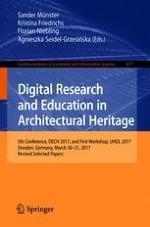2018 | Buch
Digital Research and Education in Architectural Heritage
5th Conference, DECH 2017, and First Workshop, UHDL 2017, Dresden, Germany, March 30-31, 2017, Revised Selected Papers
herausgegeben von: Sander Münster, Kristina Friedrichs, Florian Niebling, Agnieszka Seidel-Grzesińska
Verlag: Springer International Publishing
Buchreihe : Communications in Computer and Information Science
